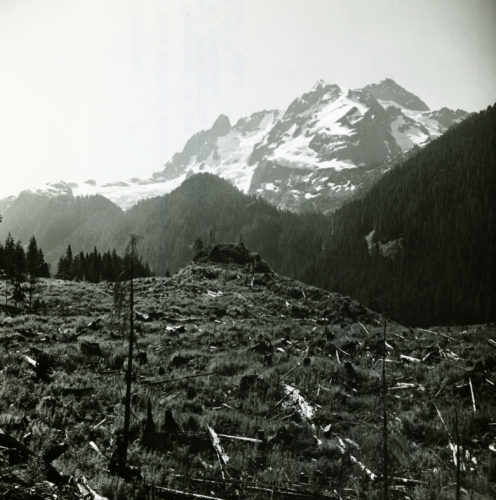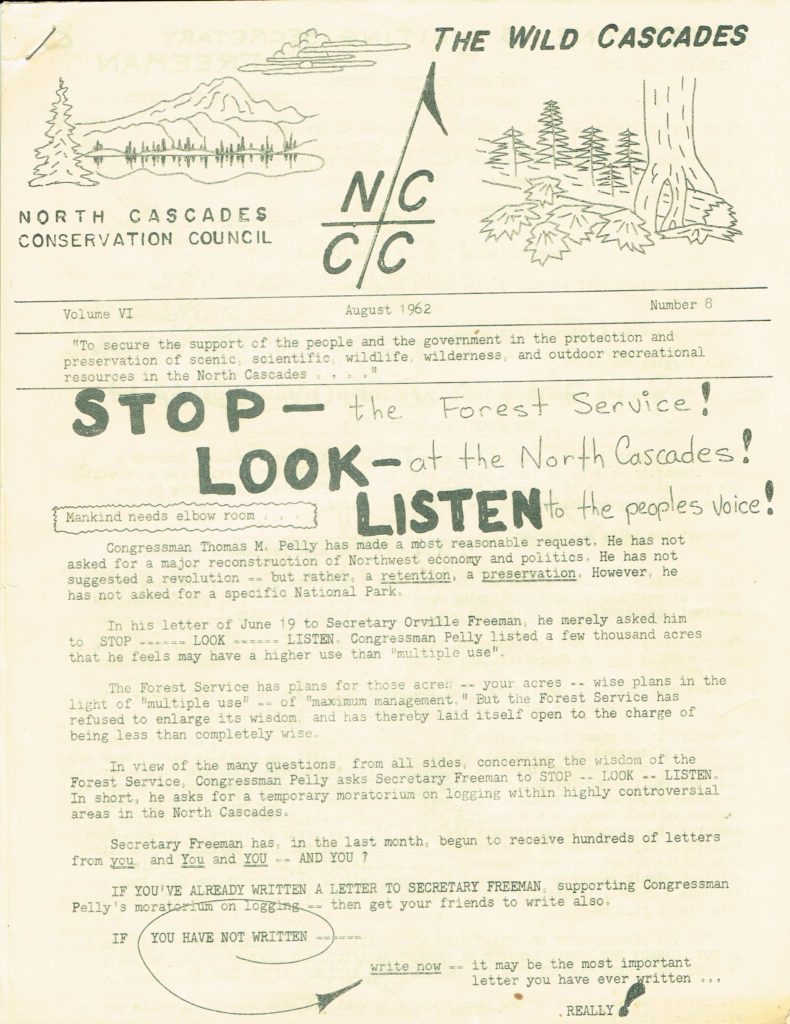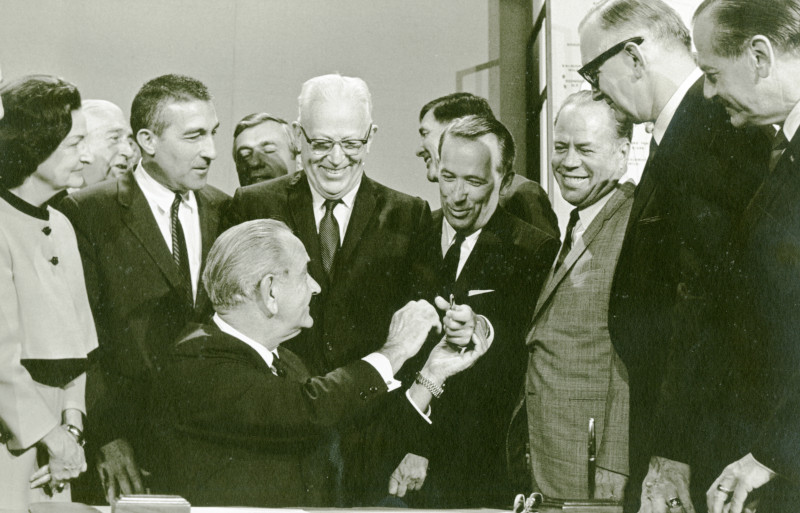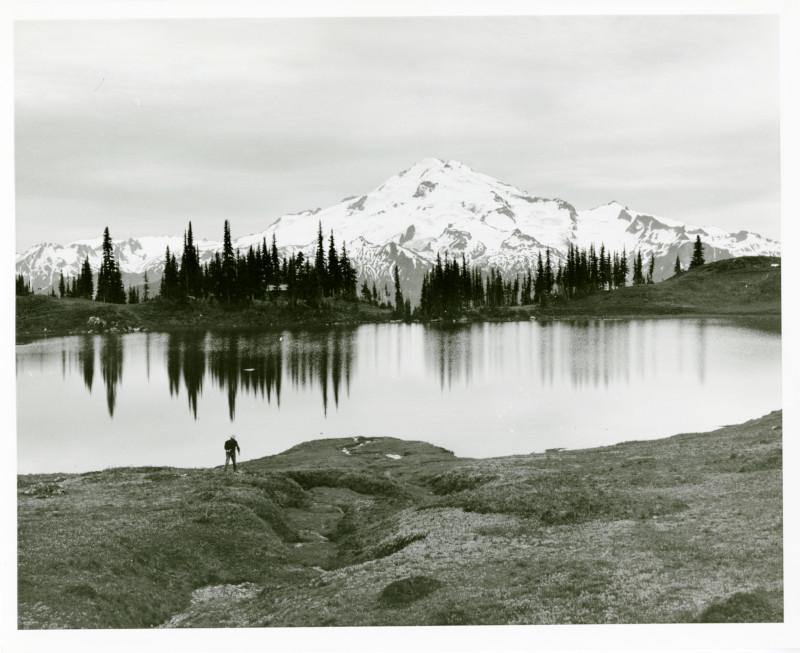Newcomers to the Pacific Northwest helped protect the North Cascades. Fifty years later, that hasn’t changed.
Political and cultural upheaval. Protests across the world. An unpopular president. Closer to home in Seattle, concerns about how to handle a flood of new residents attracted by economic opportunity in beautiful natural surroundings. Is it 2018? Yes—and 1968.
Fifty years ago, the United States was reeling from the assassinations of Martin Luther King, Jr., and Robert F. Kennedy, questioned America’s involvement in Vietnam, and pressed for changes in how the law and the larger culture treated women and minorities. Today, the country faces upheaval on a similar scale as it endures trade wars, economic inequality, attacks on immigrants, minorities, and women’s rights–not to mention threats to public lands and the environment.

As was the case fifty years ago, Cascadia now faces a population surge. Between 1950 and 1960, Seattle’s population grew an average of 175 new arrivals per week. Since 2010, Seattle has grown by about 320 people per week.
This year also marks the fiftieth anniversary of the creation of North Cascades National Park.
The park is the centerpiece of a two-million acre federal land complex—a medley of a national park, national recreation areas, and wilderness that comprises one of the wildest places in the lower 48 states. Ninety-four percent of the park complex is protected as statutory wilderness.
Perhaps paradoxically, the park might not have happened at all without the influx of people to Seattle and surrounding areas in the postwar years. The U.S. Forest Service had managed much of the Cascade Range in Washington State for more than 50 years, but there was little demand for national forest timber until World War II brought tens of thousands of new residents who sought single-family homes. Riding the midcentury economic expansion to middle-class prosperity, many newcomers to the Northwest also came for the scenery. Settled in newly built suburban developments, they spent their weekends hiking, camping, boating, and exploring the mountains they could see from their homes.
Yet even as interest in the outdoors grew, recreation seekers increasingly arrived at their favorite spots to find clearcuts, bulldozed roads, and slash piles. As the state’s private timberland was largely cutover by the early 1940s, lumber companies turned to the national forests and the Forest Service eagerly fulfilled the demand. Although the agency was charged with managing the national forests for multiple uses such as watershed protection, wildlife habitat, and recreation, the Forest Service almost always gave timber production priority, particularly in the heavily-forested Pacific Northwest.

In the mid-1950s, as more outdoors enthusiasts became distressed by what they encountered in the mountains, they asked the Forest Service to set aside more land for recreation. Glacier Peak, a remote volcano about 45 miles north of Stevens Pass, became the center of a debate about the Forest Service’s ability and willingness to preserve wilderness. Newly arrived residents —including a biochemist, a schoolteacher, and a housewife — spoke up. Enlisting the support of the Sierra Club and local outdoors groups, they formed the North Cascades Conservation Council and set in motion more than a decade of activism to protect wilderness in the North Cascades.
Although we often think of the modern environmental movement as starting in the 1960s, the North Cascades reveals that its roots stretch back a decade earlier. Economic affluence linked to wartime and postwar industries transformed the West Coast. Washington added more people than any other state but California, growing 20 percent from 1950 to 1960. According to census figures, King County alone added an average of nearly 400 people per week during that decade. As wild places were paved to make room for housing desperately needed by new arrivals, recreationists looked farther afield, to the trails and forests of the Cascade Range. Encountering the detritus of logging on their public lands, they became concerned with preserving the wilderness that remained, because it was quickly disappearing.
Federal public land agencies, particularly the Forest Service and National Park Service, struggled with the increase in outdoor recreation and demand for more wild lands. Outdoor recreationists had become conservationists, and they leveraged their increasing influence to win protection for the places they loved.
October 2, 2018, will mark the fiftieth anniversary of the park complex. This is cause for celebration. Yet the park now faces a future where climate change and population increases are likely to be the most significant instruments of change.
All of this dovetailed in the North Cascades. Its imposing topography meant that it had remained largely untouched by extractive industries like logging and mining. Thus, an area of about 10,000 square miles retained its wilderness qualities. To the conservationists, permanently protecting the North Cascades was an obvious solution, and they believed National Park Service management was superior to anything the Forest Service might provide.

The notion of mounting a campaign to preserve wilderness was so new that few had any idea of how to go about it. With the help of the Sierra Club, Seattle-area locals with an interest in the North Cascades mobilized. They attended public meetings, sent letters to elected officials and the Forest Service, and reached out to the media. In 1961, local outdoors groups pooled their resources and hired the first paid environmental lobbyist outside Washington, DC. Michael McCloskey would go on to be the Sierra Club’s longest-serving executive director, but in the early 1960s he helped formulate detailed proposals for turning the North Cascades into a large national park.
As other wilderness battles popped up around the country, elected officials started to pay attention to this seemingly new way of thinking about the environment. When President Johnson signed the Wilderness Act into law in 1964, it was clear the national zeitgeist about the natural environment had broadened. Economic prosperity created leisure time that new suburbanites spent in the mountains, where they saw the impact of their demand for single-family homes in the suburbs. They applied pressure to preserve some public lands as wilderness, arguing that wilderness was itself a resource, albeit one with a hard-to-quantify value.
Today, there are 3.4 million acres of wilderness within a 100-mile radius of Seattle, more than any other major city in the United States, created because people here demanded it.
The timing of the North Cascades debate was perfect. In the Pacific Northwest, agitation for wilderness preservation focused on our abundant forests, the source of so much historical wealth. Yes, forests resources could be converted into products that improved daily life — houses, furniture, and paper, for starters — but forests also provided a place to escape the pressures of modern life, like the traffic jams caused by the deluge of new people in Seattle. Conservationists made the case that it was important to preserve forests for their intrinsic value. They leveraged the national mood, culminating in the creation of the park.
On October 2, 1968, just two days after Boeing introduced the 747 to the world, President Johnson signed the North Cascades National Park Act into law, creating a two-unit national park, the Ross Lake and Lake Chelan national recreation areas, the Pasayten Wilderness, and additions to the Glacier Peak Wilderness. It was a bill shaped by the wilderness movement and championed by the state’s junior senator, Henry M. “Scoop” Jackson. In addition to the protections afforded by the various land designations, the act stipulated that the Forest Service and Park Service develop plans for wilderness management within two years.
October 2, 2018, will mark the fiftieth anniversary of the park complex. This is cause for celebration. Yet the park now faces a future where climate change and population increases are likely to be the most significant instruments of change. The North Cascades contain the highest concentration of glaciers in the continental U.S. Many of those glaciers are losing volume at precipitous rates, changing stream flows and wildlife habitat. As temperatures rise, some plants and animals cannot adapt, making them vulnerable to disease and dying out. Bigger, hotter wildfires affect air quality and recreation opportunities.
At the same time, more people than ever want to experience the wonders of the North Cascades. Recreation visits to the park complex, which includes the Ross Lake and Lake Chelan national recreation areas, have increased 10 percent since 2010. Undoubtedly some of the increase is attributable to the National Park Service centennial in 2016, with its popular #FindYourPark campaign. But some is also likely due to the scores of new people moving to the Puget Sound region. Just as in the 1950s, many new arrivals want to explore the mountains in person. Some trails have become so popular they are dubbed Instagram hikes, with attendant exposure on social media.
There are more people in the wilderness than ever before, and that means more impacts: more litter, more trail degradation, more cars driving mountain roads and parking along shoulders because the lot is crammed. Both the Park and Forest Services (the latter manages the land surrounding the national park complex) will have to adjust their priorities to handle the increase in visitors to both frontcountry and backcountry.

But as the conservationists a half-century ago so compellingly demonstrated, we should not leave it up to the public lands agencies to shoulder the entire burden of protection. As Sierra Club guru David Brower often said, if you enjoy wild places you have a responsibility to take care of them. So learn and practice Leave No Trace principles, and educate other hikers about them. Explore less-traveled trails (the Washington Trails Association Lost Trails Found initiative offers plenty of options) and spend a day helping with trail maintenance. Abide by regulations, stay on the trail, and don’t go places you don’t have a permit to see. Join an organization devoted to protecting the places you love. Perhaps most important, tell your elected officials that you support fully funding public lands like North Cascades National Park.
One of the most compelling aspects of the history of the North Cascades is that regular folks saw a problem, created a movement, and cemented the zeitgeist of wilderness preservation that characterizes the Pacific Northwest. Today, there are 3.4 million acres of wilderness within a 100-mile radius of Seattle, more than any other major city in the United States, created because people here demanded it. The proximity of wilderness is one of the things that attracts people to the region.
But just as in the postwar years, protection of remaining wild places will depend on those same people who move here to enjoy it. A half-century ago, economic prosperity and an influx of new residents helped make the park possible. And economic prosperity and an influx of new residents could be what helps sustain it into the future.
Photo credits: all top banner images are copyright Andy Porter Images, used with permission. 1. Diablo Lake, 2. Horseshoe Basin, 3. Easy Pass, 4. Sahale Arm.
Clearcuts near Mount Shuksan courtesy North Cascades National Park, image #NOCA 17271, Wild Cascades Newsletter courtesy of North Cascades Conservation Council, LBJ bill signing courtesy of North Cascades National Park, image #NOCA 16997, Glacier Peak from Image Lake courtesy of North Cascades National Park, image #NOCA 16609.
Lauren Danner is the author of Crown Jewel Wilderness: Creating North Cascades National Park (Washington State University Press, 2017). She lives in Olympia, Washington, and writes about outdoor recreation, environmental history, and public lands at laurendanner.com. Follow her on Twitter at @WildWithinHer.
Andy Porter is a professional photographer whose work has appeared in Backpacker magazine, Sierra, Mountaineer, Washington Trails, and Adventures NW. More info and examples of his photos can be found at Andy Porter Images.
If you appreciate articles like this on issues that matter in the Pacific Northwest, please consider becoming a supporting reader of Cascadia Magazine. We depend on the generous financial support of readers like you to pay our writers and photographers a fair rate for their work. To make a contribution, please visit our donate page.
